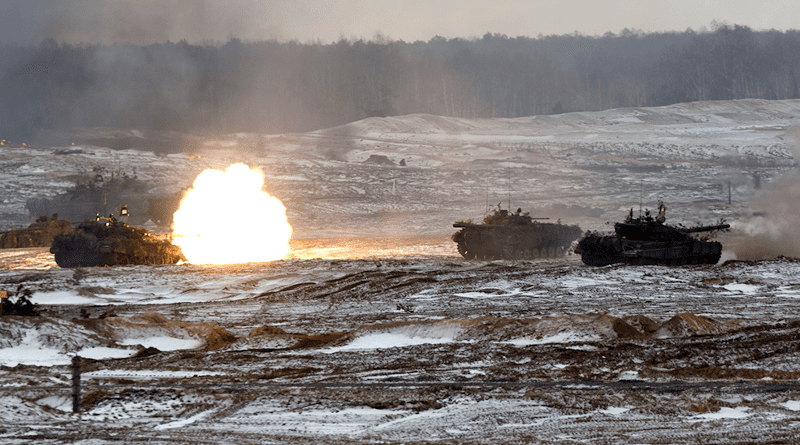Dubious Russian Claims Of ‘Doubling’ Arms Production – Analysis
By Pavel Luzin
On September 19, Russian President Vladimir Putin offered comments on the state of Russian defense production at a meeting of Russia’s Military-Industrial Commission in Izhevsk.
Putin declared that the production of battle tanks and armored vehicles had doubled from January to August 2023, as compared to the same period in 2022. He added that the production of some of the most in-demand weapon systems had tripled during that time (Kremlin.ru, September 19). Putin’s comments came after some expert evaluations in the West claimed that Russian arms manufacturing had significantly surpassed pre-2022 levels. For example, one report argued that, today, Russia is on pace to produce over two million artillery shells a year, which is double the average production rate before Moscow’s full-scale invasion of Ukraine (Mind.ua, September 9).
Earlier this year, Putin claimed that Russia will produce and modernize 1,600 main battle tanks by 2025. This means that production would have to maintain an average annual rate of 530–540 tanks. Dmitry Medvedev, deputy head of the Russian Security Council, announced that Russia had already produced 600 battle tanks from January to May 2023 (Interfax, March 25; Izvestia, June 1). However, this declaration was made without any evidence, and others estimate that the number is far lower (see EDM, August 7).
Understanding what “doubling” production rates actually means in the Russian context deserves a closer look. For many years, Moscow put its bet on modernization of those main battle tanks produced in the 1980s, 1990s and 2000s, rather than ramping up production of new tanks. In this way, the Russian military-industrial complex upgraded about 170 Soviet-era T-72 tanks to the more modernized T-72B3/B3M model annually from 2011 to 2020; this number decreased to 34 tanks in 2021. Additionally, Russia upgraded about 35 T-80BV tanks to the T-80BVM model annually from 2018 to 2021. The annual manufacturing rate for the new T-90M tanks is about 10 units. From 2018 to 2021, Russia upgraded about 20 T-90A tanks to the T-90M version annually (Bmpd.livejournal.com, February 16, 2018; Vedomosti, February 13, 2020; Topwar.ru, August 26, 2020; Rostec, August 3, 2021; TASS, January 20, 2022).
The production and modernization of the T-90M and T-80BVM tanks required a decrease in the modernization rates for the T-72B3M tanks. Consequently, Russia was only able to produce and modernize about 99 main battle tanks of the T-72B3M, T-80BVM and T-90M models in 2021, as compared to about 230 tanks at its peak in the late 2010s (Rostec, August 3, 2021). The production rate in 2022 was likely even lower due to an exponential increase in the number of tanks that needed to be repaired after fighting in Ukraine.
This reality highlights how Russia was able to “double” the production rate of main battle tanks in 2023. Moscow is merely trying to return to the production rates that it enjoyed in 2018–2020. However, these efforts have been effectively limited by Western sanctions and a severe personnel shortage in Russia’s defense industry (see EDM, May 11). Extended work shifts, shortened weekends and vacations, as well as decreased civilian production has allowed for some increase in production rates, but these actions are not sustainable (Ural-meridian.ru, April 18; Ura.ru, March 1)
Russia also relies on a sprawling network of tank repair plants. These facilities do not possess the capabilities to effectively modernize main battle tanks. Instead, they engage in repairing damaged tanks, self-propelled howitzers and armored vehicles. Additionally, these plants restore the operational status of those Soviet-era tanks and armored vehicles that were recently taken out of long-term storage (Moscow Times, August 7). The Kremlin counts such activity as “modernization” of its tanks. Thus, this approach skews the numbers and at least partially explains how Moscow plans to provide the hundreds of tanks it has promised.
Regarding artillery shell production, some pre-2022 assessments estimated that Russian production rates stood at 1.14 million a year. From 2014 to 2021, a comprehensive repair program for shells from Soviet storage added another 570,000 rounds per year (Theins.ru, August 30, 2022). Therefore, total estimates came to approximately 1.7 million artillery shells a year, both new and repaired, by 2022. Thus, Russia may have indeed been capable of increasing total annual production to two million shells, though, given the adjustment presented here, that does not mean it actually doubled production rates.
Russian arms production will continue to struggle for the foreseeable future. During the meeting with the Military-Industrial Commission, Putin announced that the new state rearmament program for 2025–2034 was still under development. He had earlier boasted that it would be ready by June 2023. The Russian president conceded that some unspecified, but significant financial and manufacturing issues have yet be resolved (Vedomosti, April 4, 2022; Kremlin.ru, September 19). The growing number of criminal cases brought against those factory heads who fail to fulfill arms production orders in time testifies of the true conditions plaguing Russia’s defense industry. And the truth strays a bit far from the optimistic estimates and declarations coming from the Kremlin (Novayagazeta.eu, September 13).
About the author: Dr. Pavel Luzin is a visiting scholar at the Fletcher School of Law and Diplomacy, Tufts University. He is also a regular contributor at The Jamestown Foundation, Riddle and the Foreign Policy Research Institute. He is a specialist in international relations and an expert on the Russian Armed Forces. Much of his research and writings focus on Russian foreign policy and defense, space policy and non-proliferation studies.
Source: This article was published by The Jamestown Foundation’s Eurasia Daily Monitor Volume: 20 Issue: 146

